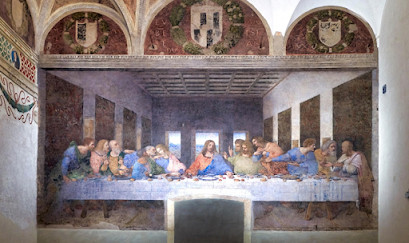Mona Lisa
Mona
Lisa
Five centuries after Leonardo
da Vinci painted the Mona
Lisa (1503–19), the portrait hangs behind bulletproof glass
within the Louvre
Museum and draws thousands of jostling spectators each day. It is
the most famous painting in the world, and yet, when viewers manage to see the
artwork up close, they are likely to be baffled by the small subdued portrait
of an ordinary woman. She’s dressed modestly in a translucent veil, dark robes,
and no jewelry. Much has been said about her smile and gaze, but viewers still
might wonder what all the fuss is about. Along with the mysteries of the
sitter’s identity and her enigmatic look, the reason for the work’s popularity
is one of its many conundrums. Although many theories have attempted to
pinpoint one reason for the art piece’s celebrity, the most compelling
arguments insist that there is no one explanation. The Mona Lisa’s
fame is the result of many chance circumstances combined with the painting’s
inherent appeal. There is no doubt that the Mona Lisa is a
very good painting. It was highly regarded even as Leonardo worked on it .
The painting presents a woman in half-body portrait,
which has as a backdrop a distant landscape . Mona Lisa, also known as La Gioconda, is the wife of Francesco del
Giocondo. This painting is painted as oil on wood. The original painting size
is 77 x 53 cm (30 x 20 7/8 in) .
Although da Vinci
began work on his masterpiece while living in his native Italy, he did not
finish it until he moved to France at King Francois I's request. The French
king displayed the painting in his Fontainebleau palace where it remained for a
century. Louis XIV removed it to the grand Palace of Versailles. At the outset
of the 19th century, Napoleon Bonaparte kept the painting in his boudoir .
Some historians believe Mona Lisa is a Self-Portrait of Leonardo da Vinci . Leonardo da Vinci died in 1519, and he is buried at a French castle .
Other revelations include:
·
Lace on Mona Lisa's dress
·
The transparency of the veil shows da Vinci first painted a
landscape and then used transparency techniques to paint the veil atop it.
·
A change in the position of the left index and middle finger.
·
The elbow was repaired from damage due to a rock thrown at the
painting in 1956.
·
The blanket covering Mona Lisa's knees also covers her stomach.
·
The left finger was not completely finished.
·
A blotch mark on the corner of the eye and chin are varnish
accidents, countering claims that Mona Lisa was sick.
· And the Mona Lisa was painted on uncut poplar board, contrary to speculations .
Who was Mona Lisa? The subject of the painting is believed to be Lisa Gherardini. She was the wife of a wealthy silk merchant from Florence named Francesco del Giocondo. Historians believe Francesco commissioned the painting for their new home to celebrate the birth of their second son, Andrea. The English title “Mona Lisa" comes from the subject's name and the Italian word “mona" (a contraction of the phrase ma donna) that means “my lady." The Italian (La Gioconda) and French (La Joconde) names of the painting come from the Italian for “jocund," which means happy or jovial. It's also a pun on the last name of Lisa's husband, Francesco del Giocondo .
The glass protecting the Mona Lisa was replaced with a bulletproof case after several attacks in 1956, one of which damaged an area near the subject’s left elbow. The Mona Lisa thus escaped harm from acts of vandalism in 1974 during the work’s visit to Tokyo and in 2009 when a museumgoer threw a ceramic mug at it .
Thank You for Read
Best wishes from
Suvendu Singha & Mamata Singha . ( India , Odisha )












Comments
Post a Comment